Modern female character design goes beyond beauty to showcase strength through resilience, emotional depth, and authenticity. Artists now balance physical power with psychological complexity, using color psychology and meaningful clothing choices to convey inner determination. Bodies and faces express confidence through thoughtful posture and expressive features, while breaking stereotypes by showing diverse backgrounds and experiences. The most compelling characters combine cultural accuracy with creative storytelling that reveals their true power within.
Key Takeaways
- Strength in female characters emerges from resilience, emotional depth, and the ability to transform challenges into opportunities for growth.
- Color psychology plays a vital role in conveying character traits, with reds suggesting determination and blues representing wisdom and inner strength.
- Effective designs balance authentic cultural representation with creative expression, avoiding stereotypes while crafting relatable backstories and flaws.
- Modern character design has evolved from one-dimensional stereotypes to complex individuals with intersectional identities and personal growth narratives.
- Clothing and accessories function as powerful visual symbols, with structured silhouettes and functional elements communicating personality and capabilities beyond beauty.
Defining Strength Beyond Physical Attributes
Strength, in all its beautiful complexity, shines far beyond bulging muscles and physical prowess when it comes to female character design.
Artists increasingly recognize that true power lies in a character’s resilience—her ability to face challenges, learn from failures, and keep moving forward despite obstacles.
Resilience isn’t just enduring hardship—it’s transforming challenges into stepping stones on the path to becoming extraordinary.
In strong female character design, emotional depth and intelligence are just as important as any physical trait. A character’s wisdom, quick thinking, or empathy can make her incredibly powerful in ways that resonate with readers.
Cultural context also shapes how strength is portrayed, as different societies value different qualities in their heroes.
Whether it’s a strategist outthinking her enemies, a leader inspiring others, or a survivor enduring hardship, these characters show that being strong comes in countless fascinating forms!
Historical Evolution of Female Portrayal in Visual Media
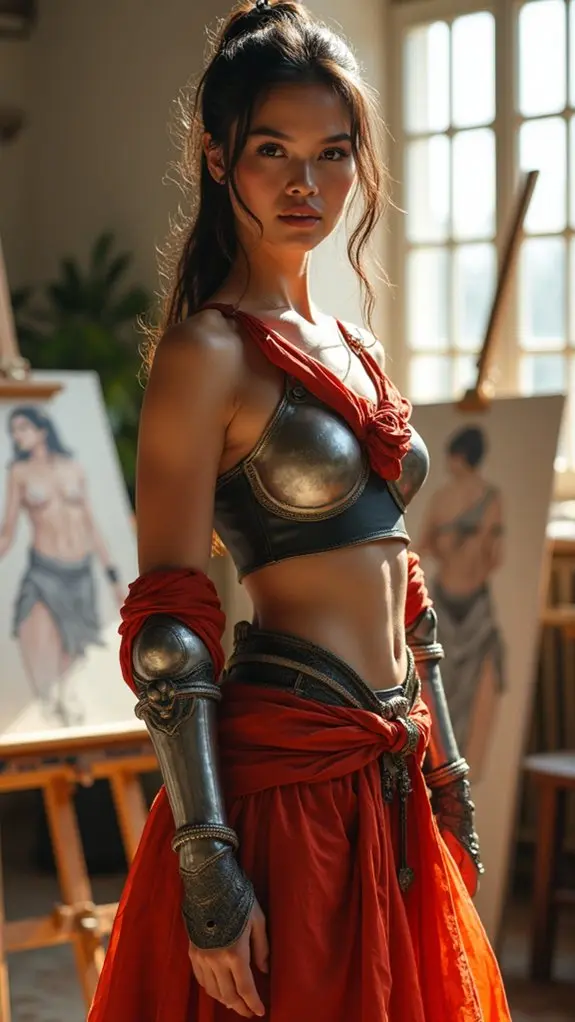
Female characters in visual media have undergone a dramatic transformation, shifting from one-dimensional stereotypes to complex, multi-faceted individuals.
Artists and designers once confined women to narrow tropes—the damsel, the mother, the temptress—but today’s creators are shattering these outdated boundaries with fresh approaches to female representation.
This evolution reflects broader societal changes, as each era’s portrayal of women reveals not just artistic trends, but the underlying values and power structures of its time.
Tropes Through Time
Throughout history, visual media has painted a fascinating picture of how society views women, creating character tropes that evolved dramatically over time. In approximately half of early representations, women were shown as delicate beauties or devoted mothers, rarely getting to be heroes or leaders. Artists using mixed media techniques—from oil paintings to early film—often reinforced these limited roles.
But wow, things have changed! Cinema broke ground with characters who could fight their own battles, and video games eventually followed suit.
Today’s female characters kick butt, solve mysteries, lead armies, and show complex emotions that feel real. The journey from decorative damsels to dynamic heroes shows how far we’ve come—and reminds us why authentic representation matters so much.
Breaking Design Boundaries
When historians look back at visual media from the past century, they clearly see a dramatic transformation in how artists portrayed women.
Female character archetypes evolved from one-dimensional domestic figures into complex heroes with genuine narrative depth. Early drawings and films limited women to pretty faces and aprons, but creators gradually expanded these boundaries, introducing visual symbolism that communicated inner strength rather than just outer beauty.
Color Psychology for Powerful Character Representation
Color choices in female character design aren’t random—they speak a secret language that connects deeply with viewers.
Red can signal a heroine’s inner fire and determination, while blues might suggest she’s both powerful and thoughtful, striking that perfect balance between strength and wisdom.
Smart designers consider not just what colors mean in one culture but how those same hues might be interpreted differently around the world, ensuring their character’s visual story translates across borders.
Symbolic Color Meanings
Visual language speaks volumes in character design, and symbolic color choices make powerful statements about female characters without saying a word. Through color symbolism analysis, artists can convey a character’s inner strength—red showcasing passion and power, blue reflecting calm confidence.
The emotional resonance exploration of green connects viewers to a character’s growth journey, highlighting her resilience and development. Yellow brings optimism to the forefront, making female characters more relatable and inspiring.
What’s fascinating is how cultural palette variations affect these meanings! The same red might symbolize luck in one culture but danger in another. Smart designers consider these differences when creating strong female characters for global audiences.
Emotional Palette Selection
Beyond symbolic meanings lies a whole world of emotional palette selection—the art of choosing colors that stir specific feelings in viewers. When designing powerful female characters, artists carefully select colors with strong emotional resonance, like fiery reds that radiate confidence or deep purples that suggest wisdom and mystery.
The psychological impact of these color choices can’t be underestimated! A character dressed in bold yellows might instantly feel optimistic and energetic, while someone in earthy tones appears more grounded and reliable.
Smart designers also consider how cultural color associations differ—what means strength in one culture might suggest something entirely different in another. This awareness helps create characters that connect across diverse audiences.
The goal? To create a color harmony that doesn’t just look pretty but actually tells us something important about who this awesome character really is!
Cultural Color Significance
When designing female characters, the cultural significance of colors plays an essential role in how audiences perceive strength and personality. Artists must consider how different cultures interpret colors to create truly powerful representations.
Red might symbolize passion in Western art but signifies good fortune in Chinese culture, dramatically changing a character’s emotional resonance.
Smart designers navigate these cultural interpretations carefully, using color symbolism that transcends borders. For example, high-contrast combinations like purple and gold can convey royalty and power across many societies, making a female character instantly recognizable as influential.
Blue paired with silver might suggest wisdom and intelligence in multiple cultures.
The most successful character designs embrace this diversity, using colors that maintain their symbolic strength across cultural boundaries while still feeling unique and personal.
Balancing Authenticity and Artistic Expression
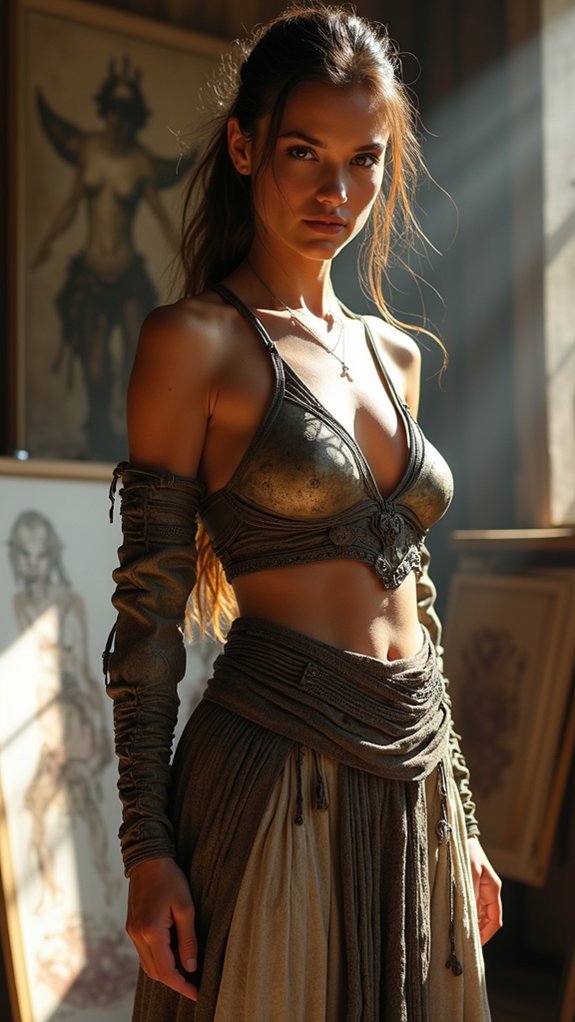
Finding the perfect balance between authentic representation and creative freedom stands at the heart of compelling female character design. Artists must research thoroughly, understanding cultural accuracy while allowing room for inspired design choices.
A well-designed female character evolves naturally within her narrative consistency, reflecting both universal and unique experiences.
Successful designers recognize that authenticity doesn’t limit creativity—it enhances it! When artists combine bold colors with functional outfits and meaningful accessories, they create characters who feel real yet visually striking.
This balance helps girls see themselves in these characters while still being wowed by artistic elements.
The most memorable female characters emerge when designers honor women’s diverse experiences while pushing creative boundaries. After all, the best character designs tell authentic stories through distinctive visual language.
Cultural Influences on Strong Female Character Design
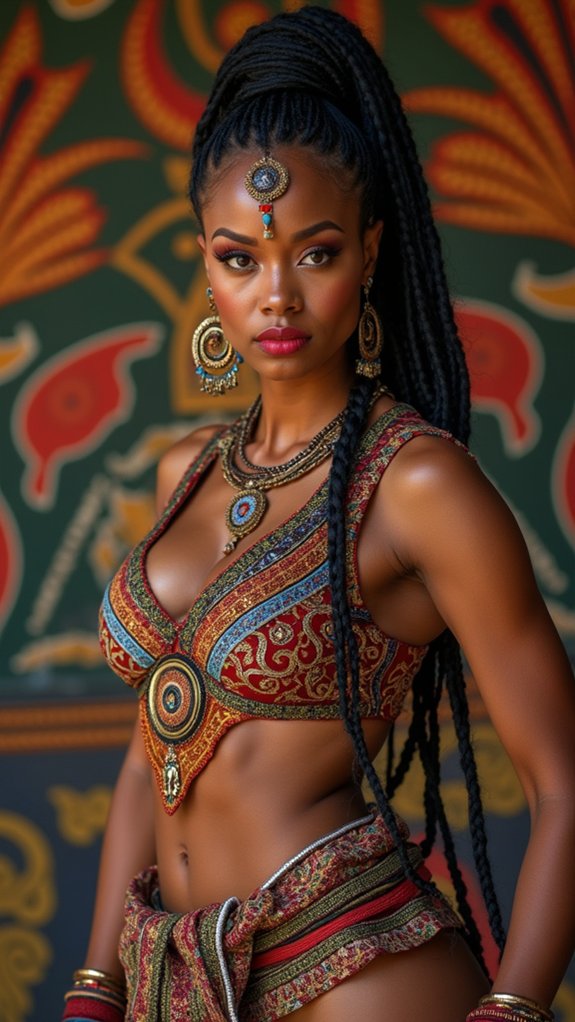
Although strong female character designs share certain qualities worldwide, cultural context shapes these heroines in fascinating ways. Different societies have unique ideas about how a strong woman looks, acts, and dresses.
Western design often emphasizes physical power and independence, while Eastern traditions might highlight inner strength and grace. Breaking cultural stereotypes while maintaining design authenticity requires artists to truly understand the societies they’re representing.
- Japanese manga often portrays strong women with both traditional values and modern determination, balancing kawaii aesthetics with fierce abilities.
- Nordic-inspired characters frequently embrace practical clothing and rugged skills, reflecting harsh environments.
- African representations celebrate vibrant colors and powerful community connections, showing strength through leadership and wisdom.
Global representation matters because when kids see heroes who look like them, they can imagine themselves being brave too!
Visual Storytelling Through Posture and Body Language
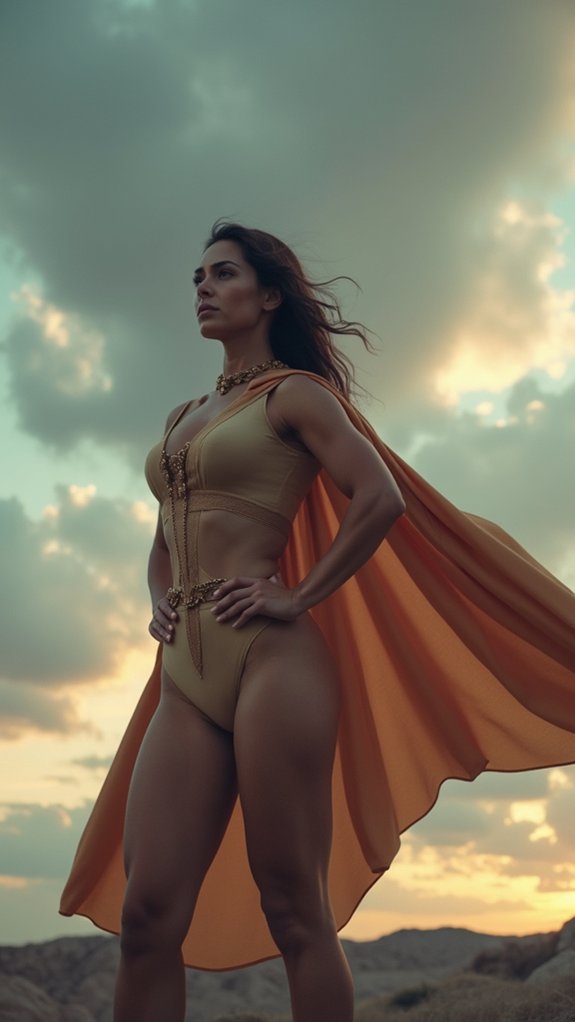
A character’s body speaks volumes before she ever says a word. Artists who master body language nuances can transform a static image into a rich narrative about confidence and inner strength. Open postures—shoulders back, arms uncrossed—suggest assertiveness, while closed postures might signal defensiveness or protection.
Body language tells a character’s story—confident poses reveal inner strength before dialogue ever begins.
Movement dynamics play a significant role too! Fluid, graceful movements often convey confidence, while stiff or hesitant motions might reveal inner conflict. When a female character stands tall with purposeful gestures, readers instantly recognize her power.
Remember that cultural interpretations of body language vary wildly around the world. A gesture that signals strength in one culture might mean something completely different elsewhere!
Smart artists research these differences to create authentic, relatable strong female characters that connect with readers from all backgrounds.
Clothing and Accessories as Power Symbols
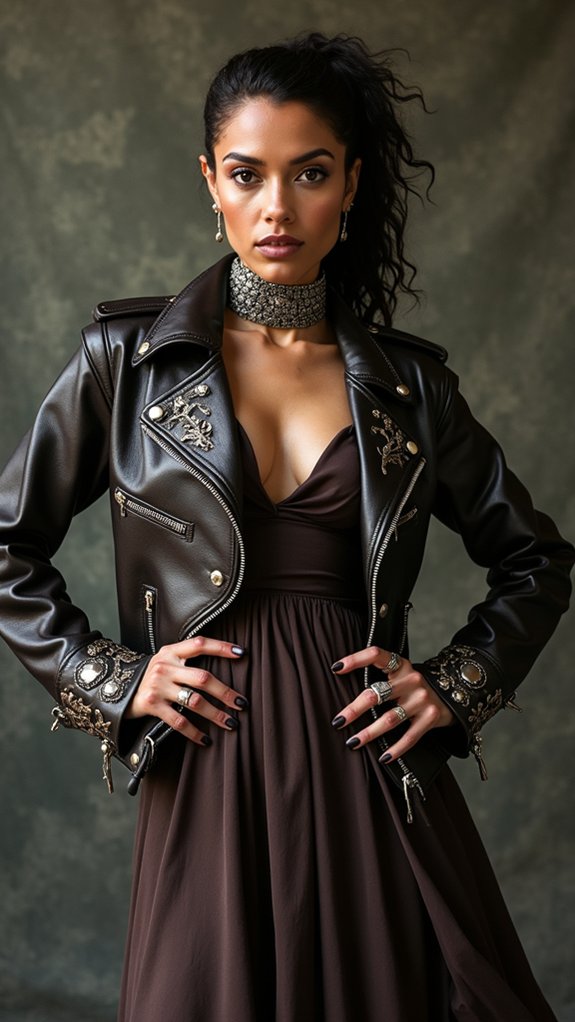
Designers craft power through every stitch and accessory in female character design. By choosing powerful silhouettes that emphasize strength rather than just beauty, artists create characters who command respect. Dark colors often show seriousness, while bright hues scream confidence!
- Structured outfits with armor-inspired elements allow heroes to look battle-ready while expressing their unique personalities.
- Functional accessories like statement weapons or practical pouches aren’t just cool—they tell stories about the character’s skills and history.
- Traditional garments get modern reinterpretation to break stereotypes, letting female characters honor their roots while kicking butt.
Gone are the days of impractical outfits that restrict movement! Today’s female character designs balance style with practicality, ensuring women can save the world without tripping over their own clothes.
After all, true power comes from being both fierce AND functional!
Breaking Stereotypes in Female Character Archetypes
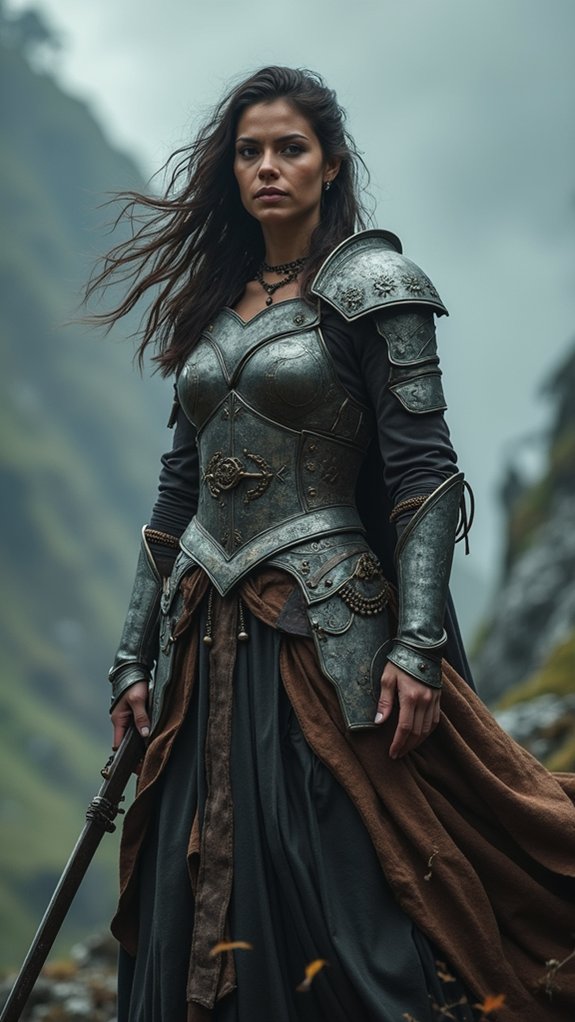
When did female characters break free from being just damsels in distress or evil temptresses? Over time, creators realized that women, like real people, deserve narrative agency and complex personalities!
Modern character design shows this exciting character evolution through intersectional representation – women of different backgrounds, abilities, and identities taking center stage.
Today’s female characters often juggle multiple skills: they might be brilliant scientists who can throw a punch, or strategic leaders with emotional depth. Their stories aren’t just about romance anymore, but about their own journeys and growth.
Technical Approaches to Capturing Determination and Resilience

Creating strong female characters requires more than just a powerful backstory—it demands thoughtful visual techniques that bring determination and resilience to life!
Artists use dynamic expressions to convey inner strength, with intense gazes and set jaws that scream confidence. Empowering silhouettes featuring open postures and bold stances communicate readiness to tackle any challenge head-on.
- Vibrant color palettes aren’t just pretty—they symbolize energy and emotional power in resilient narratives.
- Battle scars and worn equipment tell stories of past struggles without saying a word.
- Functional yet stylish outfits balance practicality with personality, showing she’s ready for action!
These technical elements work together to create female characters who aren’t just decorative—they’re forces to be reckoned with, turning visual design into powerful storytelling that breaks traditional molds.
Emotional Depth Through Facial Features and Expressions
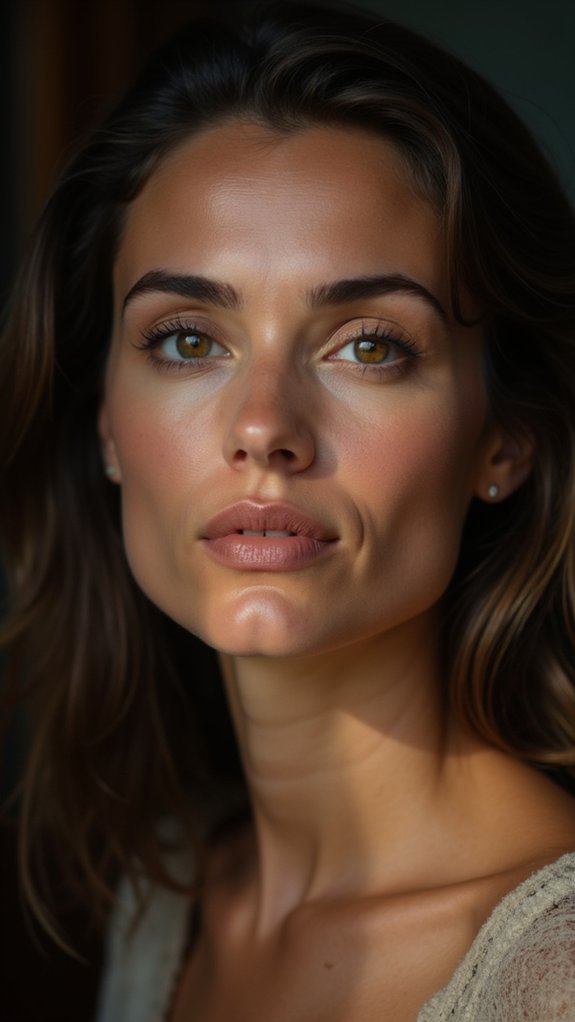
Creating lifelike female characters requires understanding how facial features convey complex emotions without a single word being spoken.
Eyes, often called “windows to the soul,” can express everything from fierce determination through a steady gaze to vulnerable tenderness with a slight downward glance.
When artists deliberately contrast facial expressions with a character’s circumstances—like a subtle smile during adversity—they create intriguing layers of complexity that make female characters feel authentic and multi-dimensional.
Subtle Emotional Cues
The magic of a compelling female character often lies in her eyes, mouth, and the subtle movements that flicker across her face. Through facial symmetry significance, artists convey internal struggles without a single word spoken.
Emotional nuance exploration happens in those quiet moments—a slightly raised eyebrow, a tightened jaw, or the gentle crease forming between her brows when she’s deep in thought.
- Small adjustments to the corners of the mouth can transform a neutral expression into one hinting at determination, sadness, or mischief.
- The eyes’ intensity can shift dramatically with subtle changes to eyelid position or pupil dilation.
- Micro-expressions lasting only seconds can reveal a character’s true feelings despite her outward composure.
Expression diversity analysis shows these tiny details aren’t just artistic choices—they’re the difference between a flat character and one bursting with authentic humanity.
Eyes Tell Stories
Windows to the soul, eyes serve as powerful storytelling tools in female character design. Artists carefully craft eye shapes to reveal personality traits—large, round eyes often suggest innocence or wonder, while narrowed eyes might hint at determination or skepticism.
The positioning of eyebrows and eyelids adds layers to these emotional signals, instantly communicating feelings without a single word.
Eye symbolism varies dramatically across cultures, making expressive shapes a universal yet nuanced language in character art. A Japanese manga character’s eyes differ from Western comic styles, but both speak volumes about who she is!
Color choices matter too—a character with fiery amber eyes tells a different story than one with cool blue ones. When designing female characters, artists know that eyes don’t just see—they speak, revealing inner worlds that draw readers into the story.
Contrast Creates Complexity
Beyond the story eyes tell, a character’s face becomes truly fascinating when artists play with contrasting elements. Facial dynamics create emotional depth when designers mix seemingly opposite features – like a tough warrior with unexpectedly soft lips or a gentle healer with intense, piercing eyes.
These emotional contrasts help middle school artists create characters that feel real and complex!
- A character with narrowed eyes but a wide, friendly smile creates an intriguing mix of suspicion and warmth
- Combining culturally diverse facial expressions can make your character seem mysterious or show their mixed heritage
- Playing with unexpected expressive nuances – like a villain who shows brief moments of genuine sadness – adds layers to your story
When different facial elements clash in purposeful ways, your female characters jump off the page with believable complexity!
Frequently Asked Questions
How Do Industry Deadlines Affect Female Character Design Processes?
Industry deadlines create design challenges that often result in creative compromises. Deadline pressures can force artists to prioritize expedience over nuanced development, potentially reinforcing stereotypes rather than challenging them.
What Software Best Captures Female Character Strength and Complexity?
No single program defines character depth. Digital painting tools like Procreate, 3D modeling software like ZBrush, and character animation apps like Maya all contribute when artists prioritize nuanced representation.
How Might Viewer Demographics Influence Strong Female Character Designs?
Viewer demographics shape character designs through audience perception of gender stereotypes and cultural representation. Age, gender, and cultural background influence how strength in female characters is interpreted and received.
Can Minor Female Characters Exhibit Strength Without Extensive Development?
Minor female characters can demonstrate strength through impactful presence and subtle character depth. Even with limited screentime, effective minor strength representation often relies on concise, meaningful characterization moments.
What Ethical Considerations Arise When Designing Diverse Female Characters?
Ethical design requires authentic cultural representation, conscious stereotype avoidance, and recognition of intersectional identities. Creators must research thoroughly, consult diverse voices, and acknowledge their own biases when crafting female characters.
Conclusion
The evolution of female character design continues to break boundaries, offering artists exciting ways to showcase women’s strength beyond muscles alone. By considering history, psychology, and cultural context, creators can design female characters who inspire through their complexity and authenticity. As art pushes past tired stereotypes, we all benefit from characters who reflect the true power of women—found in their determination, wisdom, and unwavering spirit.


Leave a Reply